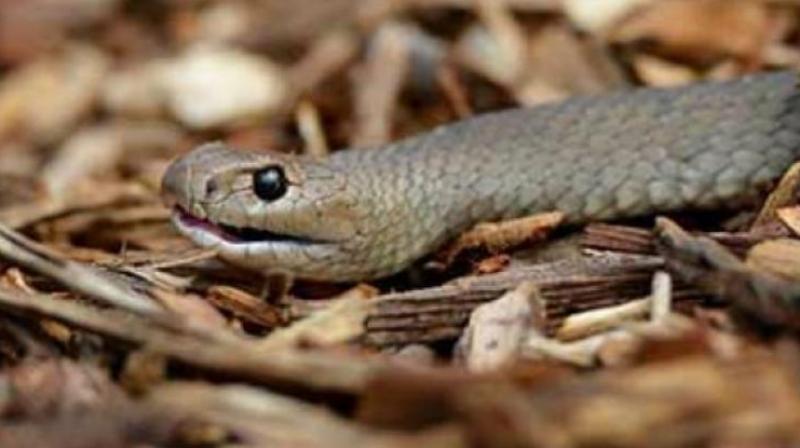Telangana: Snakes targeted, killed en masse

Hyderabad: Large number of snakes are being killed to cater to the increasing demand for skin and venom for both legal and illegal uses. At the same time, most of what is claimed to be snake venom is not really so, according to experts. Some species of snakes are strictly protected under the wildlife Act. Recently, Rs 250 crore worth of material claimed to be snake venom was seized in West Bengal. Before that, two people from Kuppam were arrested in Bengaluru for selling a drug laced with cobra venom. A gang of snake smugglers was caught in the Vizag agency area.
The Friends of Snakes Society believes that in most cases the confiscated venom is actually just water, honey and artificial colours. With the Union ministry of health ordering all state health departments to stock anti-venom, demand has gone up. An officer of the Telangana forest department's wildlife wing said that Irula Snake Catchers Industrial Cooperative Society of Mamallapuram in TN supplies venom to companies making anti-venom jabs.
“With demand for venom increasing, the society is not able to supply enough. On the other hand, snake habitats are being destroyed, leading to more rescues and bites. Recently, we received a request from the customs and excise department to help them analyse the venom they had seized,” he said. In May 2016, a gang from Khammam district was caught extracting cobra venom in Srikakulam district and supplying it to pharmaceutical companies.
In January 2016, Bengaluru Central Crime Branch sleuths arrested two persons identified as Zameer Ahmed, 47, a mathematics lecturer, and Pyare Jaan, 70, both residents of Kuppam, for possessing drugs mixed with cobra venom. Mr Avinash Visvanathan of the Friends of Snakes Society, Hyderabad, said, “There have been many cases where people are taken into custody while selling venom. Ideally, it should be a punishable offence under the Wildlife (Protection) Act 1972.”
He said most of those caught do not possess venom in the first place. The venom gets denatured and loses its properties within minutes of extraction. Venom has to be preserved by lyophilisation or freeze-drying immediately. “In West Bengal, police said they seized two kilos of crude venom stored in five bottles. Even if we assume that it is venom, it is worthless,” he said. He said it was impossible for a few individuals to collect 10 kg of venom. “If one is able to extract 0.5 grams of dried venom from each snake they would require 20,000 snakes to obtain 10 kilos. In this case, the accused should be tried under Section 420 IPC (cheating).”
Junkies now go for snake venom:
Minute quantities of snake venom, either mixed with some drug or taken directly as injection, is popular among drug addicts for its analgesic and euphoric effects. Wildlife veterinary expert Dr M. Naveen Kumar, a consultant with the Nehru Zoological Park, said that in India, anti- venom was made from only four snake varieties. “Snake venom is used as a narcotic drug. Apart from manufacturing anti-venom, it is also used in research for treatment for certain ailments. Smugglers use glass tubes to extract venom by making the snakes spit out the liquid. The liquid is then converted into powder.”
Mr Avinash Viswanathan of the Friends of Snakes Society said, “Most of the time venom is sought by individuals for use as a psycho active drug. Venom causes excruciating pain within the body and damage to tissues at the bite site and also kidneys. So using it as a drug will cause trauma instead of a high.” Apart from that, snakes are dunked in liquor for that supposed extra ‘kick’. The CCMB’s LaCONES conducted a DNA test on a snake in a wine bottle and found that it was an Indo-Chinese spitting cobra. The bottle was seized from a bar in Bengaluru.
Narrating the incident, LaCONES genetic scientist Dr Ajay Gaur said, “The authorities suspected that the snake was an Indian cobra (Naja naja), which is a scheduled animal under the Indian Wildlife (Protection) Act 1972. Based on morphological examination, other authorities like the Zoological Survey of India, Southern Regional Station, Chennai, and Bombay Natural History Society certified that it was an Indian cobra. However, in order to conclusively settle identity of the species, the specimen was sent to us for DNA typing.” Genome sequencing showed it to be an Indo-Chinese spitting cobra (N. siamensis) and not Naja naja. “On the basis of our report, the authority filed a case against the bar owners for illegal hunting of a venomous snake, which is also an endangered species according to the Convention on International Trade in Endangered Species of Wild Fauna and Flora,” said Dr Gaur.

